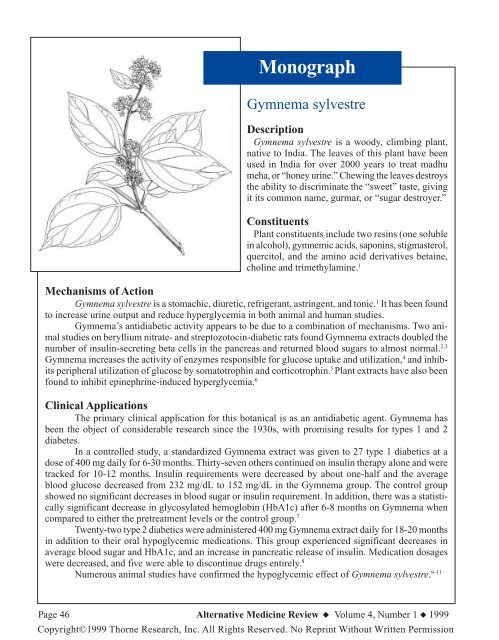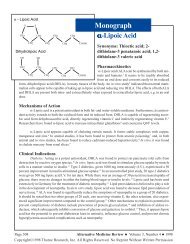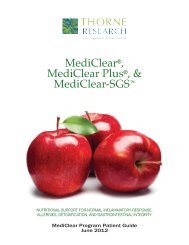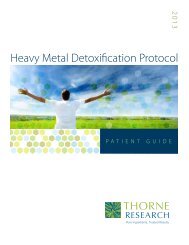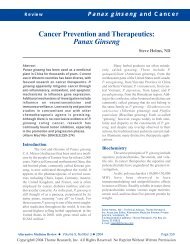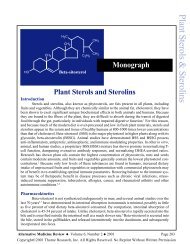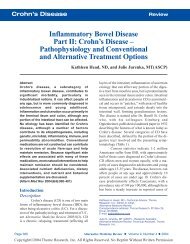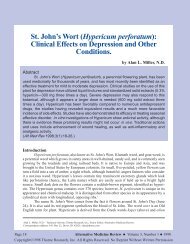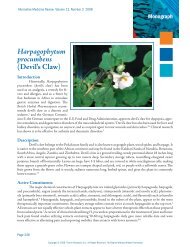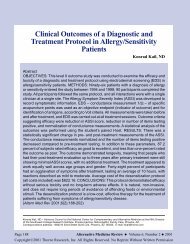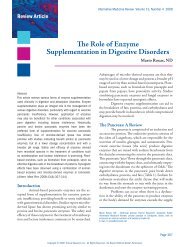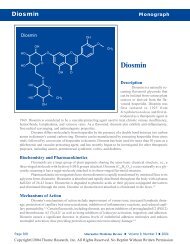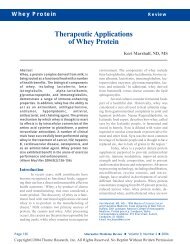Gymnema sylvestre - Thorne Research
Gymnema sylvestre - Thorne Research
Gymnema sylvestre - Thorne Research
You also want an ePaper? Increase the reach of your titles
YUMPU automatically turns print PDFs into web optimized ePapers that Google loves.
Monograph<strong>Gymnema</strong> <strong>sylvestre</strong>Description<strong>Gymnema</strong> <strong>sylvestre</strong> is a woody, climbing plant,native to India. The leaves of this plant have beenused in India for over 2000 years to treat madhumeha, or “honey urine.” Chewing the leaves destroysthe ability to discriminate the “sweet” taste, givingit its common name, gurmar, or “sugar destroyer.”ConstituentsPlant constituents include two resins (one solublein alcohol), gymnemic acids, saponins, stigmasterol,quercitol, and the amino acid derivatives betaine,choline and trimethylamine. 1Mechanisms of Action<strong>Gymnema</strong> <strong>sylvestre</strong> is a stomachic, diuretic, refrigerant, astringent, and tonic. 1 It has been foundto increase urine output and reduce hyperglycemia in both animal and human studies.<strong>Gymnema</strong>’s antidiabetic activity appears to be due to a combination of mechanisms. Two animalstudies on beryllium nitrate- and streptozotocin-diabetic rats found <strong>Gymnema</strong> extracts doubled thenumber of insulin-secreting beta cells in the pancreas and returned blood sugars to almost normal. 2,3<strong>Gymnema</strong> increases the activity of enzymes responsible for glucose uptake and utilization, 4 and inhibitsperipheral utilization of glucose by somatotrophin and corticotrophin. 5 Plant extracts have also beenfound to inhibit epinephrine-induced hyperglycemia. 6Clinical ApplicationsThe primary clinical application for this botanical is as an antidiabetic agent. <strong>Gymnema</strong> hasbeen the object of considerable research since the 1930s, with promising results for types 1 and 2diabetes.In a controlled study, a standardized <strong>Gymnema</strong> extract was given to 27 type 1 diabetics at adose of 400 mg daily for 6-30 months. Thirty-seven others continued on insulin therapy alone and weretracked for 10-12 months. Insulin requirements were decreased by about one-half and the averageblood glucose decreased from 232 mg/dL to 152 mg/dL in the <strong>Gymnema</strong> group. The control groupshowed no significant decreases in blood sugar or insulin requirement. In addition, there was a statisticallysignificant decrease in glycosylated hemoglobin (HbA1c) after 6-8 months on <strong>Gymnema</strong> whencompared to either the pretreatment levels or the control group. 7Twenty-two type 2 diabetics were administered 400 mg <strong>Gymnema</strong> extract daily for 18-20 monthsin addition to their oral hypoglycemic medications. This group experienced significant decreases inaverage blood sugar and HbA1c, and an increase in pancreatic release of insulin. Medication dosageswere decreased, and five were able to discontinue drugs entirely. 8Numerous animal studies have confirmed the hypoglycemic effect of <strong>Gymnema</strong> <strong>sylvestre</strong>. 9-11Page 46 Alternative Medicine Review ◆ Volume 4, Number 1 ◆ 1999Copyright©1999 <strong>Thorne</strong> <strong>Research</strong>, Inc. All Rights Reserved. No Reprint Without Written Permission
<strong>Gymnema</strong> <strong>sylvestre</strong>Dosage and ToxicityThe typical therapeutic dose of an extract, standardized to contain 24-percent gymnemic acids,is 400-600 mg daily. It is not clear from examining the studies whether divided doses is ideal but,because it is being used to regulate blood sugar, three divided doses with meals would seem ideal.No significant adverse effects have been reported, aside from the expected hypoglycemia. 12Safety in pregnancy has not been established.References1. Kapoor LD. Handbook of Ayurvedic Medicinal Plants. Boca Raton, FL:CRC Press, Inc; 1990:200-201.2. Prakash AO, Mather S, Mather R. Effect of feeding <strong>Gymnema</strong> <strong>sylvestre</strong> leaves on blood glucose in berylliumnitrate treated rats. J Ethnopharmacol 1986;18:143-146.3. Shanmugasundaram ER, Gopinath KL. Shanmugasundaram KR, Rojendran VM. Possible regeneration of theislets of Langerhans in streptozotocin-diabetic rats given <strong>Gymnema</strong> <strong>sylvestre</strong> leaf extracts. J Ethnopharmacol1990;30:265-279.4. Shanmugasundaram KR, Panneerselvam C, Samudram P, Shanmugasundaram ER. Enzyme changes and glucoseutilisation in diabetic rabbits: the effect of <strong>Gymnema</strong> <strong>sylvestre</strong>, R.Br. J Ethnopharmacol 1983;7:205-234.5. Gupta SS, Variyar MC. Experimental studies on pituitary diabetes IV. Effect of <strong>Gymnema</strong> <strong>sylvestre</strong> and Cocciniaindica against the hyperglycemia response of somatotropin and corticotrophin hormones. Indian J Med Res1964;52:200-207.6. Gupta SS. Inhibitory effect of <strong>Gymnema</strong> <strong>sylvestre</strong> (Gurmar) on adrenaline induced hyperglycemia in rats. Indian JMed Sci 1961;15:883-887.7. Shanmugasundaram ER, Rajeswari G, Baskaran K, et al. Use of <strong>Gymnema</strong> <strong>sylvestre</strong> leaf in the control of bloodglucose in insulin-dependent diabetes mellitus. J Ethnopharmacol 1990;30:281-294.8. Baskaran K, Ahamath BK, Shanmugasundaram KR, Shanmugasundaram ER. Antidiabetic effect of a leaf extractfrom <strong>Gymnema</strong> <strong>sylvestre</strong> in non-insulin-dependent diabetes mellitus patients. J Ethnopharmacol 1990;30:295-305.9. Srivasta Y, Bhatt HV, Prem AS, et al. Hypoglycemic and life-prolonging properties of <strong>Gymnema</strong> <strong>sylvestre</strong> leafextract in diabetic rats. Isr J Med Sci 1985;21:540-542.10. Okabayashi Y, Tani S, Fujisawa T, et al. Effect of <strong>Gymnema</strong> <strong>sylvestre</strong>, R.Br. on glucose homeostasis in rats.Diabetes Res Clin Pract 1990;9:143-148.11. Venkatakrishna-Bhatt H, Srivastava Y, Jhala CI, et al. Effect of <strong>Gymnema</strong> <strong>sylvestre</strong>, R.Br. leaves on blood sugarand longevity of alloxan diabetic rats. Indian J Pharmacol 1981;13:99.12. Facts and Comparisons Publishing Group. The Review of Natural Products. St. Louis, MO: Facts and Comparisons,a Wolters Kluwer Co; 1996.Alternative Medicine Review ◆ Volume 4, Number 1 ◆ 1999 Page 47Copyright©1999 <strong>Thorne</strong> <strong>Research</strong>, Inc. All Rights Reserved. No Reprint Without Written Permission


